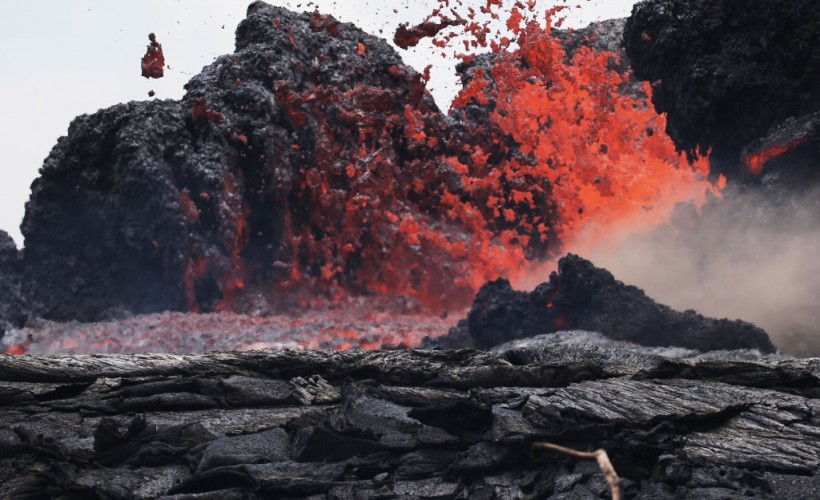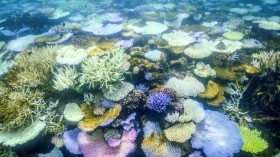Hawaii's Kilauea volcano has historically been the most active of the five volcanoes in Hawaii's Big Island. While it does not make it to the news from time to time, Kilauea has actually been erupting continuously since the 19th century.
On 24 May 1969, the youngest volcano in the island started off the historical Maunaulu eruption with a deep rumbling. When it erupted, the lava poured continuously for a total of 1,774 days, making it the longest Kīlauea eruption in at least 2,000 years. In that year alone, twelve giant lava fountains erupted at the same site, creating a rare symmetrical dome fountain captured in 'glorious' photographs.

PAHOA, HI - MAY 24: Lava erupts from a Kilauea volcano fissure in Leilani Estates, on Hawaii's Big Island, on May 24, 2018 in Pahoa, Hawaii. An estimated 40-60 cubic feet of lava per second is gushing from volcanic fissures in Leilani Estates.
For many years, it was believed that Kīlauea was only a bulge and "mere satellite of its giant neighbor". However, research over the past few decades proved that it clearly has its own magma-plumbing system, extending to the surface from more than 60 km deep in the earth.
Since then, the magma reservoir underneath exhibited magnificent activity that lasted for five straight years, and continued being active until 2018.
Maunaulu's lava dome and "growing mountain"

PAHOA, HI - MAY 24: Lava erupts from a Kilauea volcano fissure in Leilani Estates, on Hawaii's Big Island, on May 24, 2018 in Pahoa, Hawaii. An estimated 40-60 cubic feet of lava per second is gushing from volcanic fissures in Leilani Estates.
Since the 5-year eruption of Maunaulu, the cooling lava have been creating a whole new landscape on the side of Kīlauea earning its name of the "growing mountain".
In 2018, the United States Geological Survey (USGS) reposted a photo of the dome fountain episode that occurred last October 10-13, 1969. The photo portrayed how the phenomenon generated "one of the rarest types of a lava fountain".
Typically, lave explosions are not intact and goes all over the place. Which is why the perfectly rounded dome fountain was deemed special for having "rhyme and reason".
According to USGS records, at some point the fountain may have reached as high as 75 meters (246 feet).
Also read: Volcanic Eruptions Contribute to Collapse of Chinese Dynasties in the Last 200 Decades, Study Finds
The spectacular high 'lava falls'
If you found the lava dome rather spectacular, the fountain of splattering of boiling hot rock was also notable at that point in the eruption. During that time, high 'lava falls' overflowed the 'Alae Crater on Kīlauea.
"For the two seasoned observers who witnessed this awe-inspiring event, nothing else matched it during the entire Maunaulu eruption," USGS writes on their website.
"This fountain lasted a little over 9 hours and reached a maximum height of 220 m (500 ft) during the fourth episode of high/sustained fountaining of Mauna Ulu eruption. It is a good example of what many volcanologists term a Hawaiian fountain."
Nine years after Maunaulu ceased, Kīlauea barely took rests. It produced regular stunts of lava explosions since 1983 up until 2018, including the catastrophic the Pu'u'ō'ō eruption.
Aside from the lava dome and fountain, the volcano also hosted an active lava pond at the summit, emitting vigorous gas plume from 2008 to 2018.
"In 2018, the decades-long continuous activity on the East Rift Zone ended, and the summit lava lake drained following an intrusion into, and eruption from, Kīlauea's lower East Rift Zone," USGS wrote.
Also read: Hazardous Ozone Spikes at Western Cities, Posing Health Risks to Millions
© 2024 NatureWorldNews.com All rights reserved. Do not reproduce without permission.

![Microplastics Escape Body's Gut to 'Infiltrate' the Brain, Kidneys and Liver [Study]](https://1471793142.rsc.cdn77.org/data/thumbs/full/70195/280/157/50/40/microplastics-escape-bodys-gut-to-infiltrate-the-brain-kidneys-and-liver-study.jpg)



